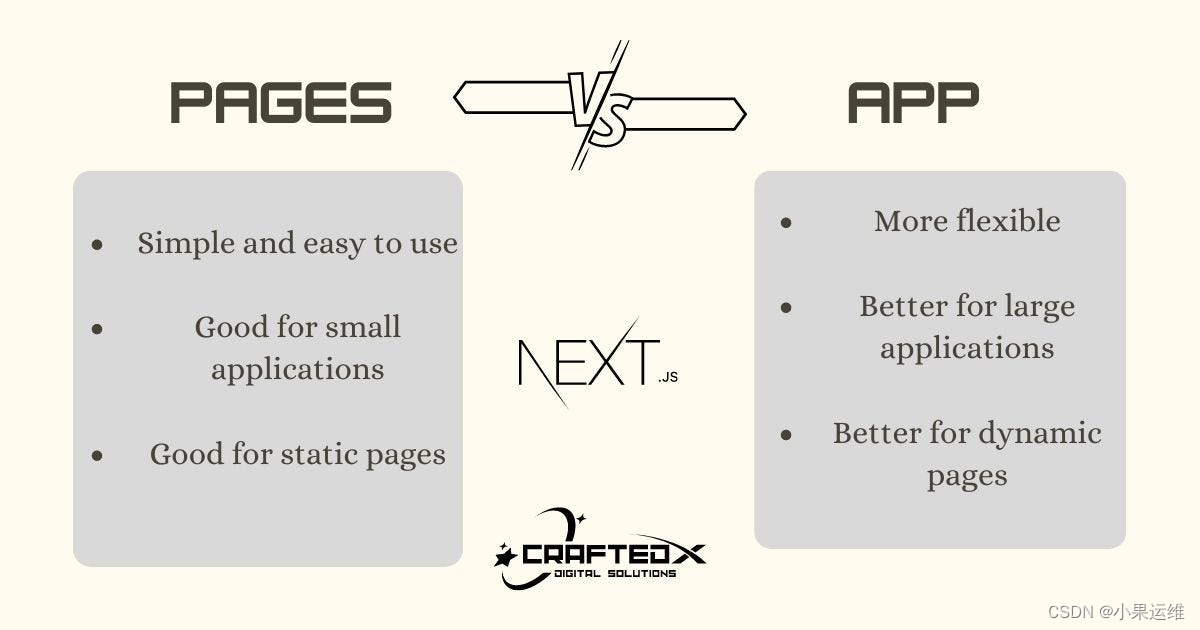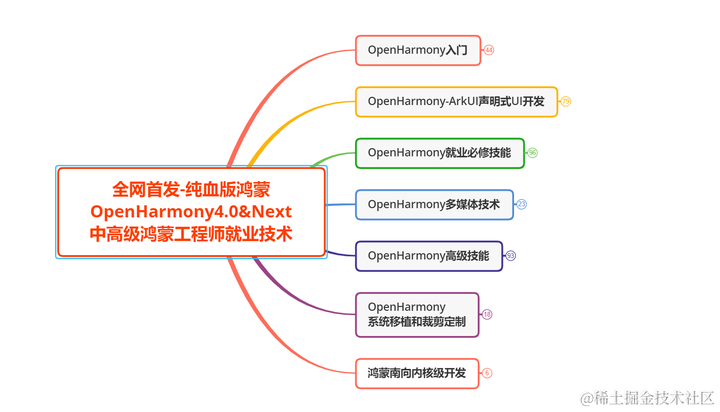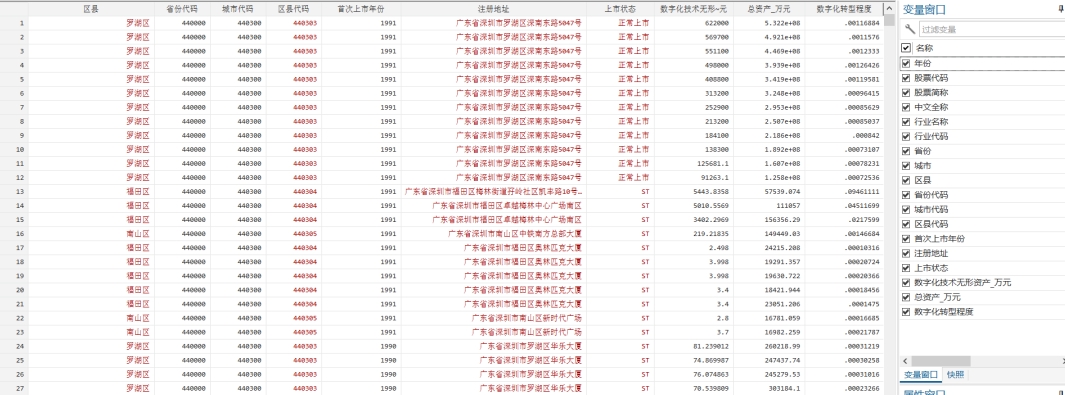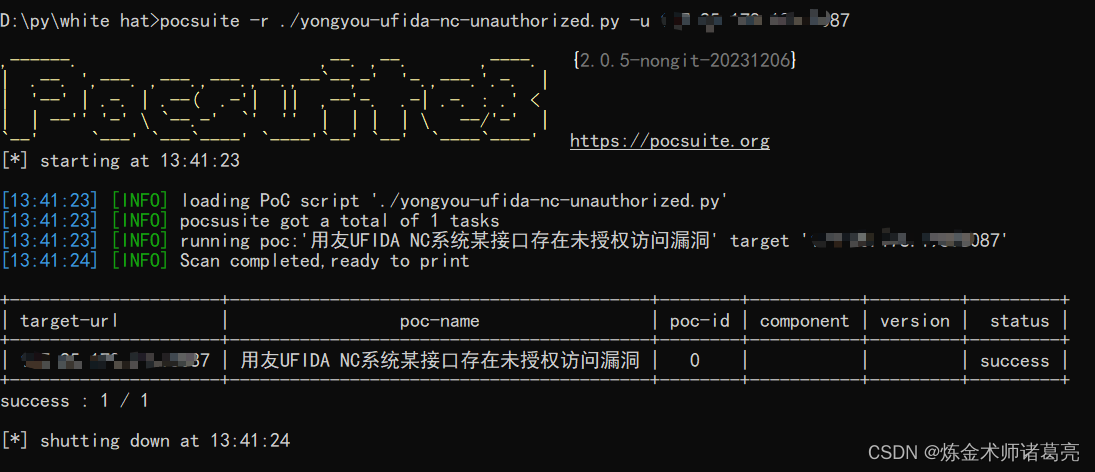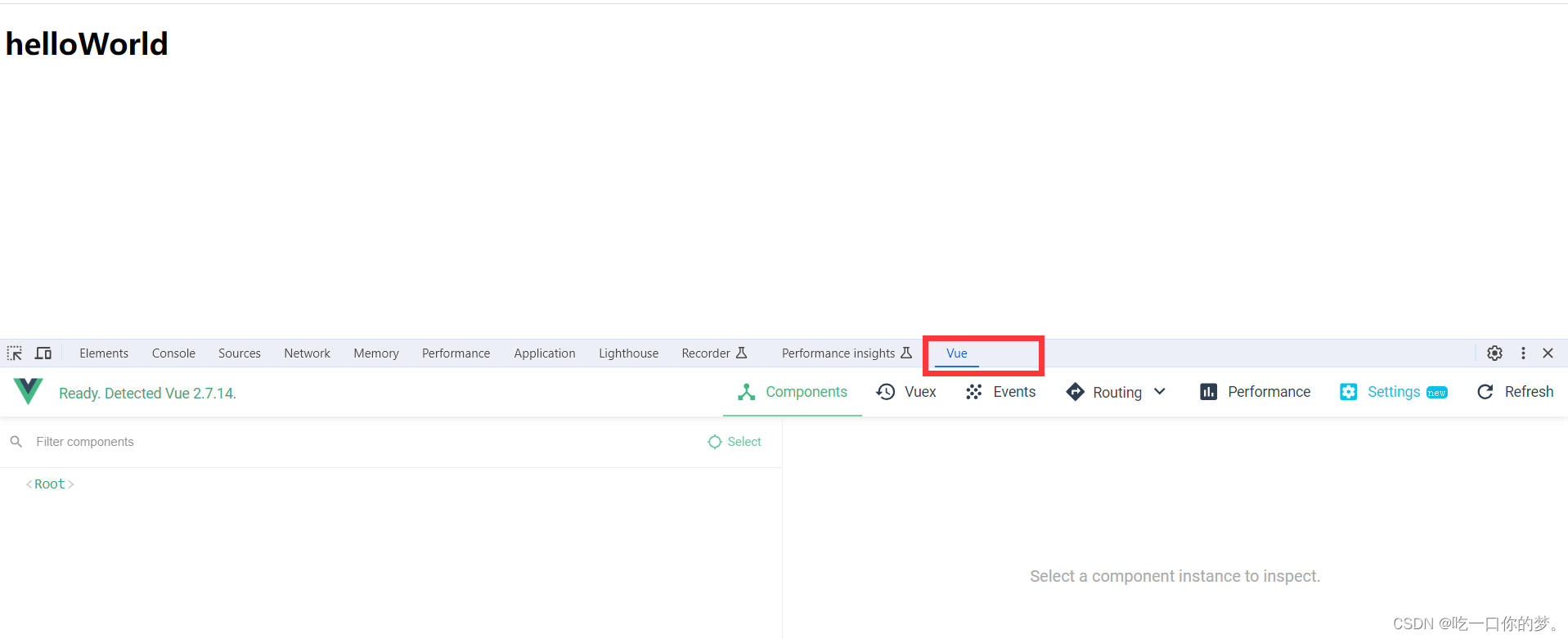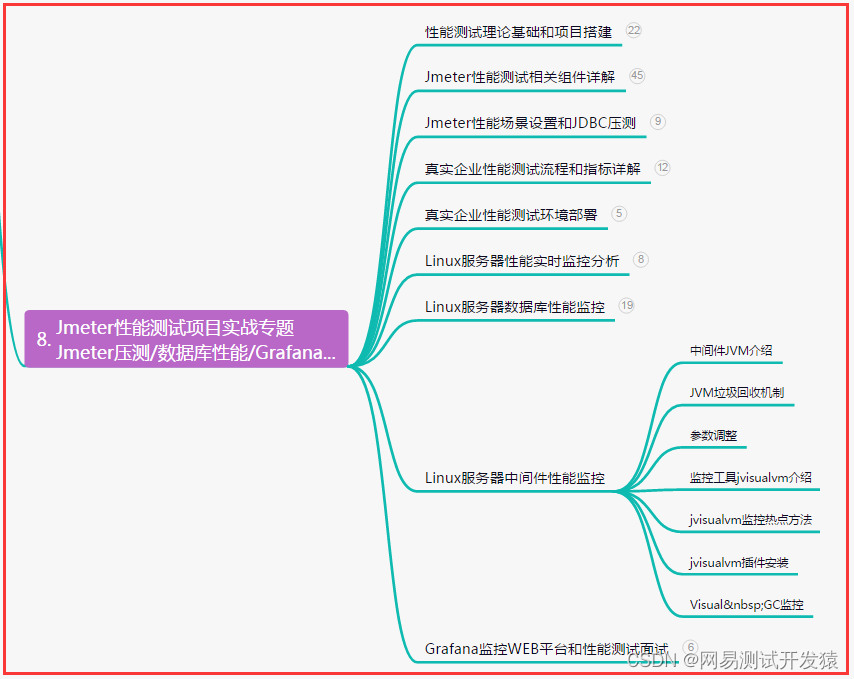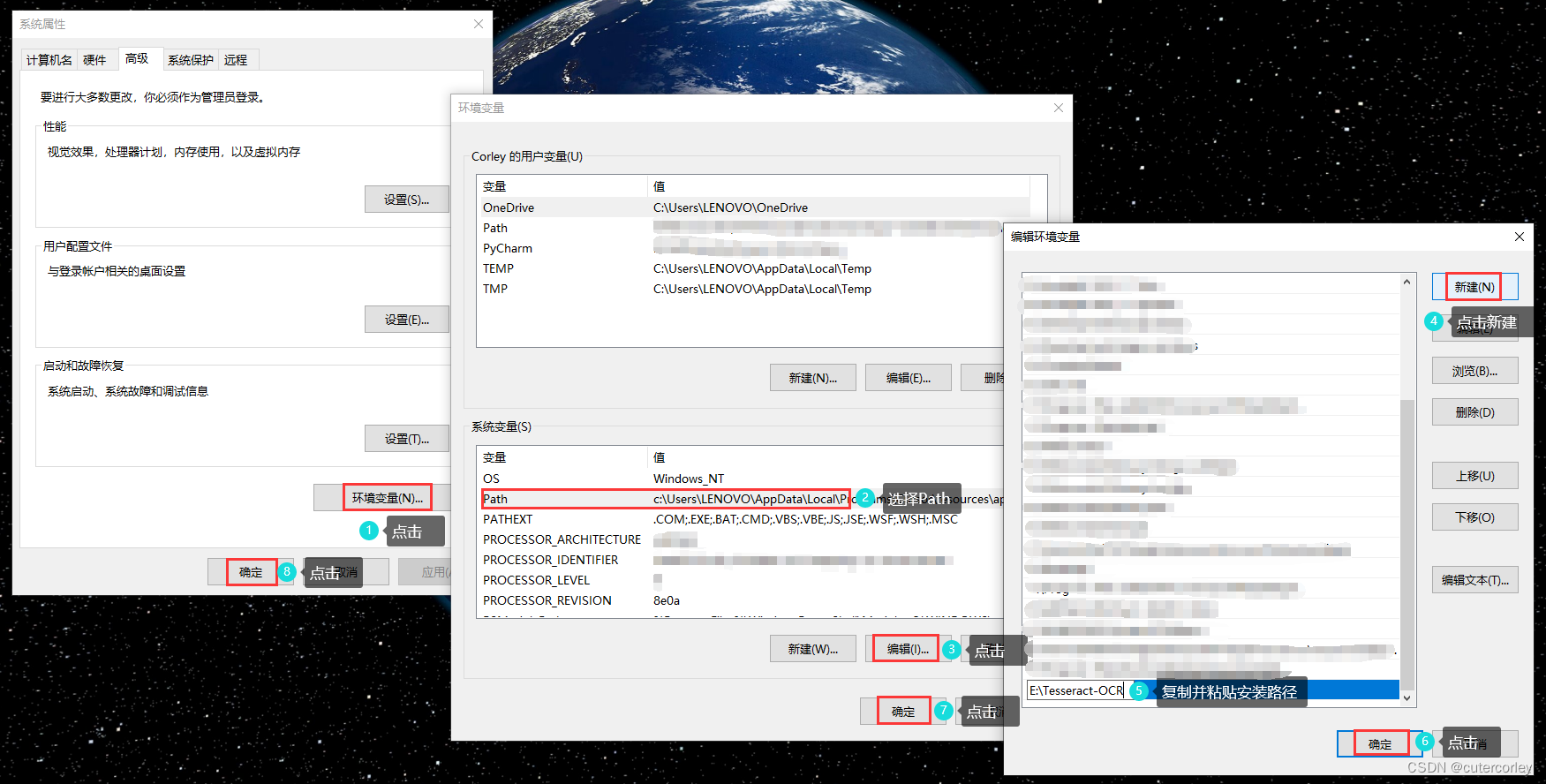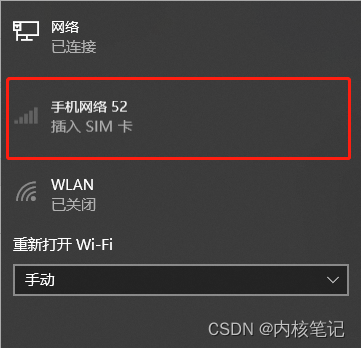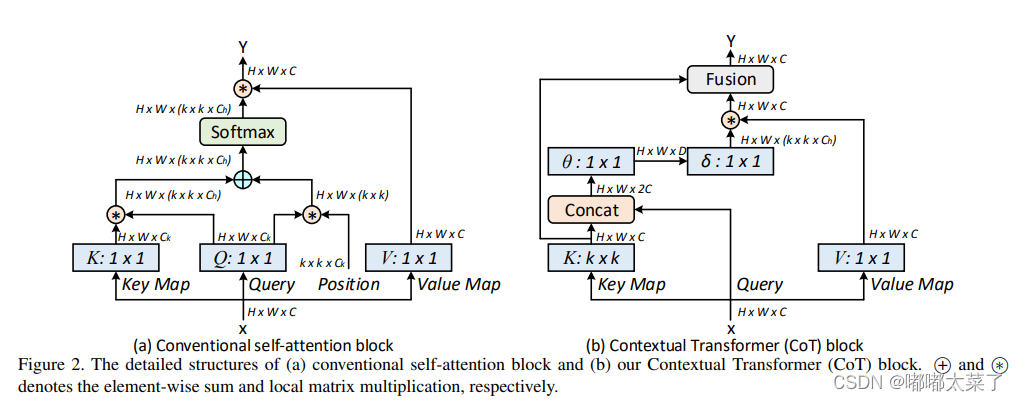文章目录
- 一、Servlet
- 1、Servlet概述和运行流程
- 2、开发过程(xml和注解方式)
- 3、Servlet生命周期
- 4、Servlet继承结构
- 4.1、Servlet规范接口
- 4.2、ServletConfig配置接口
- 4.3、GenericServlet抽象类
- 4.4、HttpServlet抽象类
- 5、ServletConfig和ServletContext
- 6、HttpServletRequest和HttpServletRequest
- 二、过滤器
- 1、过滤器概述
- 2、过滤器使用
- 2.1、Filter接口
- 2.2、web.xml配置过滤器
- 2.3、@WebFilter注解方式配置过滤器
- 三、监听器
- 1、监听器概述
- 2、application域监听器
- 3、session域的两个特殊监听器
- 3.1、session绑定监听器
- 3.2、钝化活化监听器
一、Servlet
1、Servlet概述和运行流程
概述
- Servlet (server applet) 是运行在服务端(
tomcat)的Java小程序 - Servlet主要负责接收处理请求、协同调度功能以及响应数据
- Servlet是运行在服务端的,Servlet必须在WEB项目中开发且在Tomcat这样的服务容器中运行
Servlet的请求和响应流程
- tomcat接收到请求后,会将请求报文的信息转换一个
HttpServletRequest对象- 该对象中包含了请求中的所有信息(请求行、请求头、请求体)
- tomcat同时创建了一个
HttpServletResponse对象,该对象用于承装要响应给
客户端的信息- 该对象后面会被转换成响应的报文(响应行、响应头、响应体)
- tomcat根据请求中的资源路径找到对应的
servlet,将servlet实例化,调用
service方法- 同时将HttpServletRequest 和HttpServletResponse对象传入
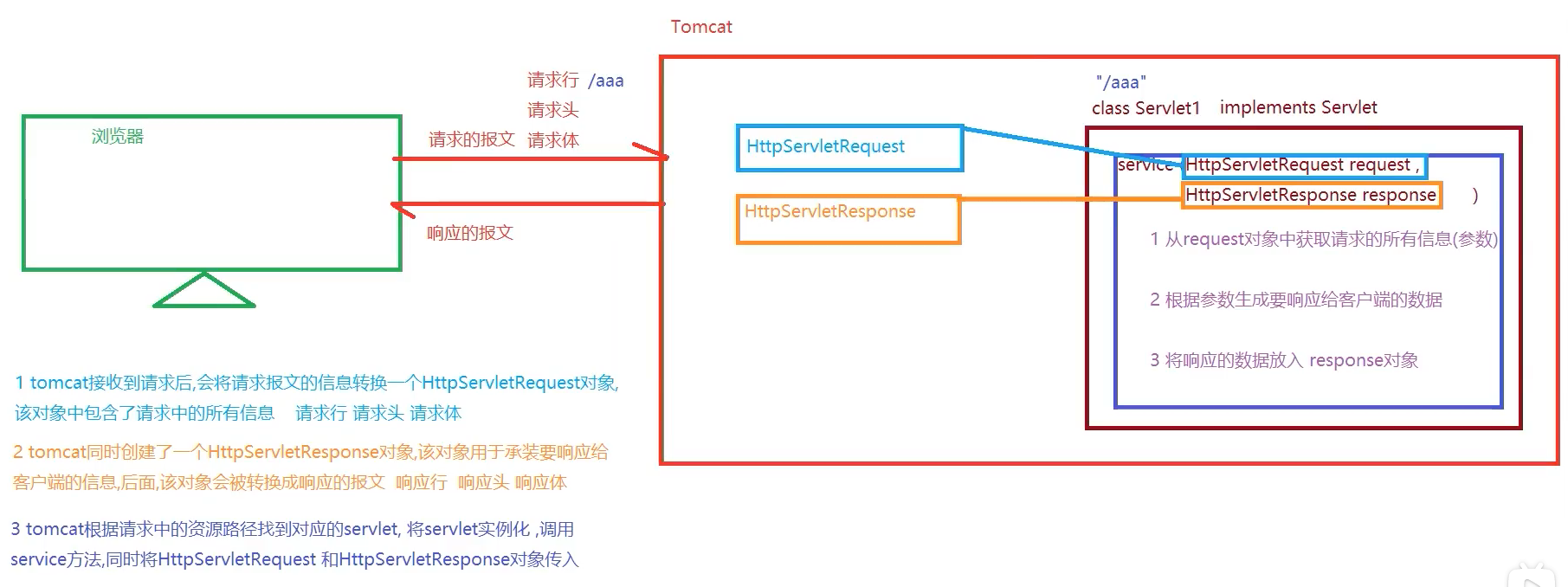
- 同时将HttpServletRequest 和HttpServletResponse对象传入
2、开发过程(xml和注解方式)
web.xml方式
pom文件:
<?xml version="1.0" encoding="UTF-8"?>
<project xmlns="http://maven.apache.org/POM/4.0.0"
xmlns:xsi="http://www.w3.org/2001/XMLSchema-instance"
xsi:schemaLocation="http://maven.apache.org/POM/4.0.0 http://maven.apache.org/xsd/maven-4.0.0.xsd">
<modelVersion>4.0.0</modelVersion>
<groupId>com.xc.mvc</groupId>
<artifactId>springmvc</artifactId>
<version>1.0-SNAPSHOT</version>
<packaging>war</packaging>
<dependencies>
<!-- ServletAPI -->
<dependency>
<groupId>javax.servlet</groupId>
<artifactId>javax.servlet-api</artifactId>
<version>4.0.0</version>
<scope>provided</scope>
</dependency>
</dependencies>
<build>
<plugins>
<plugin>
<groupId>org.apache.maven.plugins</groupId>
<artifactId>maven-compiler-plugin</artifactId>
<configuration>
<!--配置Maven中Java的编译版本 -->
<source>1.8</source>
<target>1.8</target>
</configuration>
</plugin>
</plugins>
</build>
</project>
web.xml:
<?xml version="1.0" encoding="UTF-8"?>
<web-app xmlns="http://xmlns.jcp.org/xml/ns/javaee"
xmlns:xsi="http://www.w3.org/2001/XMLSchema-instance"
xsi:schemaLocation="http://xmlns.jcp.org/xml/ns/javaee http://xmlns.jcp.org/xml/ns/javaee/web-app_4_0.xsd"
version="4.0">
<servlet>
<!--给UserServlet起一个别名-->
<servlet-name>myServlet</servlet-name>
<servlet-class>com.xc.mvc.servlet.MyServlet</servlet-class>
<!--初始化参数-->
<init-param>
<param-name>k1</param-name>
<param-value>v1</param-value>
</init-param>
<init-param>
<param-name>k2</param-name>
<param-value>v2</param-value>
</init-param>
</servlet>
<servlet-mapping>
<!--关联别名和映射路径-->
<servlet-name>myServlet</servlet-name>
<!--可以为一个Servlet匹配多个不同的映射路径,但是不同的Servlet不能使用相同的url-pattern-->
<url-pattern>/myServlet</url-pattern>
<!-- <url-pattern>/myServlet2</url-pattern>-->
<!--
/ 表示通配所有资源,不包括jsp文件
/* 表示通配所有资源,包括jsp文件
/a/* 匹配所有以a前缀的映射路径
*.action 匹配所有以action为后缀的映射路径
-->
<!-- <url-pattern>/*</url-pattern>-->
</servlet-mapping>
</web-app>
Servlet程序:
public class MyServlet extends HttpServlet {
@Override
protected void doPost(HttpServletRequest req, HttpServletResponse resp) {
System.out.println("hello world");
}
@Override
protected void doGet(HttpServletRequest req, HttpServletResponse resp) {
this.doPost(req,resp);
}
}
启动tomcat,访问浏览器
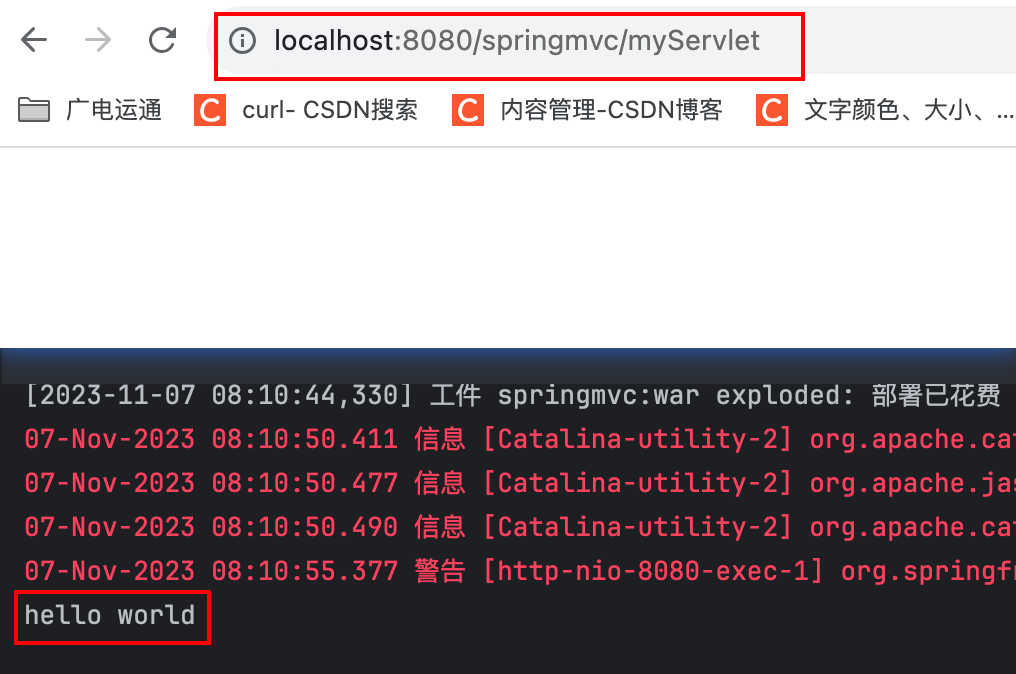
@WebServlet注解方式
- nane:相当于<servlet-name>,别名,一般不用设置
- urlPatterns:相当于<url-pattern>,匹配路径
- / 表示通配所有资源,
不包括jsp文件 - /* 表示通配所有资源,包括jsp文件
- /a/* 匹配所有以a前缀的映射路径
- *.action 匹配所有以action为后缀的映射路径
- / 表示通配所有资源,
- initParams:初始化参数,只有当前Servlet的程序中可以获取到(后面讲)
- loadOnStartup:Servlet是否在项目加载(tomcat启动)时实例化
- 默认-1,tomcat启动不实例化
- 因为有很多Servlet,包括自定义和tomcat内置, loadOnStartup数字越小越早实例化
- 这里配置6,因为tomcat内部的web.xml配置的Servlet的loadOnStartup已经到5
- 其实即使数字一样,也会正常运行
@WebServlet(
name = "userServlet",
//value = "/user",
urlPatterns = {"/userServlet","/userServlet1","/userServlet2"},
initParams = {
@WebInitParam(name = "k1",value = "v1"),
@WebInitParam(name = "k2",value = "v2")
},
loadOnStartup = 6
)
public class MyServlet extends HttpServlet {
@Override
protected void doPost(HttpServletRequest req, HttpServletResponse resp) {
System.out.println("hello world");
}
@Override
protected void doGet(HttpServletRequest req, HttpServletResponse resp) {
this.doPost(req,resp);
}
}
3、Servlet生命周期
- 简单的叙述生命周期,就是对象在容器中从开始创建到销毁的过程
- Servlet对象是Servlet容器
创建的,生命周期方法都是由容器(目前我们使用的是Tomcat)调用的
Servlet主要的生命周期执行特点
| 生命周期 | 对应方法 | 执行时机 | 执行次数 |
|---|---|---|---|
| 构造对象 | 构造器 | 第一次请求或者容器启动 | 1 |
| 初始化 | init() | 构造完毕后或者容器启动 | 1 |
| 处理服务 | service(req, resp) | 每次请求 | 多次 |
| 销毁 | destory() | 容器关闭 | 1 |
代码测试:
@WebServlet("/servletlifecycle")
public class ServletLifeCycle extends HttpServlet {
public ServletLifeCycle(){
System.out.println("构造器");
}
@Override
public void init() throws ServletException {
System.out.println("初始化方法");
}
@Override
protected void service(HttpServletRequest req, HttpServletResponse resp) throws ServletException, IOException {
System.out.println("service方法");
}
@Override
public void destroy() {
System.out.println("销毁方法");
}
}
启动tomcat,浏览器访问http://localhost:8080/springmvc/servletlifecycle,控制台打印:
构造器
初始化方法
service方法
关闭tomcat服务器,控制台打印:
销毁方法
特别说明
- 服务器启动,控制台没有任何输出,说明ServletLifeCycle对象没实例化、初始化
- 如果@WebServlet注解添加属性
loadOnStartup = 1,服务启动时候,构造器和init方法就会执行
4、Servlet继承结构
抽象父类HttpServlet的类图
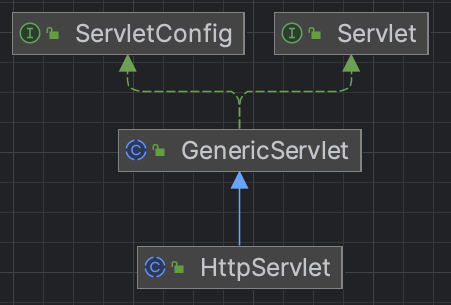
4.1、Servlet规范接口
- init方法
- 容器在构造servlet对象后,自动调用的方法
- 容器负责实例化一个ServletConfig对象,并在调用该方法时传入
- ServletConfig对象可以为Servlet 提供初始化参数
- service方法
- 处理请求并做出响应的服务方法,每次请求产生时由容器调用
- 容器创建一个ServletRequest对象和ServletResponse对象,容器在调用service方法时,传入这两个对象
- destroy方法
- Servlet实例在销毁之前调用的方法
public interface Servlet {
# 初始化方法
void init(ServletConfig config) throws ServletException;
# 获取ServletConfig对象
ServletConfig getServletConfig();
# service(服务)
void service(ServletRequest req, ServletResponse res) throws ServletException, IOException;
# 获取servlet的信息
String getServletInfo();
# destroy(销毁)
void destroy();
}
4.2、ServletConfig配置接口
public interface ServletConfig {
# 获取Servlet的名称 -----> 可能和web.xml里面的 servlet-name 有关系
String getServletName();
# 获取上下文ServletContext对象
ServletContext getServletContext();
# 获取初始化参数
String getInitParameter(String name);
# 获取初始化的参数列表--可以理解为Iterable迭代去
Enumeration<String> getInitParameterNames();
}
4.3、GenericServlet抽象类
- tomcat创建ServletConfig对象,并且调用init方法,传入config
init和destroy方法都是空实现,子类去实现,调用时机tomcat来把握- ServletConfig对象可以获取此Servlet的
初始化参数和全局上下文对象 - service核心方法这里依然只是声明,需要子类去重写
public abstract class GenericServlet
implements Servlet, ServletConfig, java.io.Serializable
{
private transient ServletConfig config;
public GenericServlet() { }
// tomcat创建ServletConfig对象
// 并且调用init方法,传入config
public void init(ServletConfig config) throws ServletException {
this.config = config;
this.init();
}
// 这里是空实现,留给子类重写
public void init() throws ServletException {
}
// 实现Servlet规范的销毁方法,但是空实现
// 这样继承GenericServlet就可以选择是否重写destroy都可以
public void destroy() {
}
// 获取初始化时候,tomcat传入的ServletConfig对象
public ServletConfig getServletConfig() {
return config;
}
/**
* 通过ServletConfig对象获取初始化参数,通过key获取value
*/
public String getInitParameter(String name) {
ServletConfig sc = getServletConfig();
if (sc == null) {
throw new IllegalStateException(
lStrings.getString("err.servlet_config_not_initialized"));
}
return sc.getInitParameter(name);
}
/**
* 获取所有的初始化参数
* Enumeration可以理解为Iterable迭代器
* hasMoreElements判断是否有值,nextElement获取值
*/
public Enumeration<String> getInitParameterNames() {
ServletConfig sc = getServletConfig();
if (sc == null) {
throw new IllegalStateException(
lStrings.getString("err.servlet_config_not_initialized"));
}
return sc.getInitParameterNames();
}
// 获取上下文对象ServletContext的方法
public ServletContext getServletContext() {
ServletConfig sc = getServletConfig();
if (sc == null) {
throw new IllegalStateException(
lStrings.getString("err.servlet_config_not_initialized"));
}
return sc.getServletContext();
}
// 返回空
public String getServletInfo() {
return "";
}
// 服务方法再次声明,需要子类去实现
public abstract void service(ServletRequest req, ServletResponse res)
throws ServletException, IOException;
/**
* 返回Servlet的名称
*/
public String getServletName() {
ServletConfig sc = getServletConfig();
if (sc == null) {
throw new IllegalStateException(
lStrings.getString("err.servlet_config_not_initialized"));
}
return sc.getServletName();
}
}
4.4、HttpServlet抽象类
public abstract class HttpServlet extends GenericServlet {
//请求会先访问这个service
public void service(ServletRequest req, ServletResponse res) throws ServletException, IOException {
if(req instanceof HttpServletRequest && res instanceof HttpServletResponse) {
//将req 和res强制转换为带Http的request 和response
HttpServletRequest request = (HttpServletRequest)req;
HttpServletResponse response = (HttpServletResponse)res;
//然后调用带Http req和res的service方法
this.service((HttpServletRequest)request, (HttpServletResponse)response);
} else {
throw new ServletException("non-HTTP request or response");
}
}
protected void service(HttpServletRequest req, HttpServletResponse resp) throws ServletException, IOException {
//获得请求方法的类型
String method = req.getMethod();
long errMsg;
//如果是GET请求
if(method.equals("GET")) {
errMsg = this.getLastModified(req);
if(errMsg == -1L) {
//调用doGet方法
this.doGet(req, resp);
} else {
long ifModifiedSince = req.getDateHeader("If-Modified-Since");
if(ifModifiedSince < errMsg) {
this.maybeSetLastModified(resp, errMsg);
this.doGet(req, resp);
} else {
resp.setStatus(304);
}
}
//如果是HEAD请求
} else if(method.equals("HEAD")) {
errMsg = this.getLastModified(req);
this.maybeSetLastModified(resp, errMsg);
this.doHead(req, resp);
//如果是POST请求
} else if(method.equals("POST")) {
this.doPost(req, resp);
//如果是PUT请求
} else if(method.equals("PUT")) {
this.doPut(req, resp);
//如果是DELETE请求
} else if(method.equals("DELETE")) {
this.doDelete(req, resp);
//如果是OPTIONS请求
} else if(method.equals("OPTIONS")) {
this.doOptions(req, resp);
} else if(method.equals("TRACE")) {
this.doTrace(req, resp);
} else {
String errMsg1 = lStrings.getString("http.method_not_implemented");
Object[] errArgs = new Object[]{method};
errMsg1 = MessageFormat.format(errMsg1, errArgs);
resp.sendError(501, errMsg1);
}
}
// 不论get还是post,抛出异常405或400
protected void doGet(HttpServletRequest req, HttpServletResponse resp)
throws ServletException, IOException
{
String protocol = req.getProtocol();
String msg = lStrings.getString("http.method_get_not_supported");
if (protocol.endsWith("1.1")) {
// HttpServletResponse.SC_METHOD_NOT_ALLOWED = 405
resp.sendError(HttpServletResponse.SC_METHOD_NOT_ALLOWED, msg);
} else {
// HttpServletResponse.SC_BAD_REQUEST = 400
resp.sendError(HttpServletResponse.SC_BAD_REQUEST, msg);
}
}
protected void doPost(HttpServletRequest req, HttpServletResponse resp)
throws ServletException, IOException
{
String protocol = req.getProtocol();
String msg = lStrings.getString("http.method_post_not_supported");
if (protocol.endsWith("1.1")) {
resp.sendError(HttpServletResponse.SC_METHOD_NOT_ALLOWED, msg);
} else {
resp.sendError(HttpServletResponse.SC_BAD_REQUEST, msg);
}
}
...
}
- 将ServletRequest和ServletResponse参数强制转换为
HttpServletRequest和HttpServletResponse - 希望子类去重写需要的请求方式的具体实现,如果不重写但发请求报错405,如下:
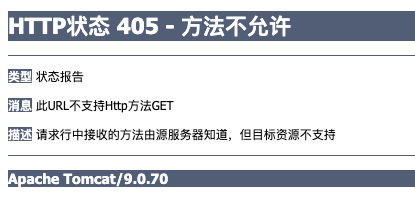
5、ServletConfig和ServletContext
ServletConfig
- 为Servlet提供
初始配置参数的一种对象,每个Servlet都有自己独立唯一的ServletConfig对象 - 容器会为每个Servlet实例化一个ServletConfig对象,并通过Servlet生命周期的init方法传入给Servlet作为属性

xml配置
<servlet>
<servlet-name>servletA</servlet-name>
<servlet-class>com.xc.servlet.ServletA</servlet-class>
<!--配置ServletA的初始参数-->
<init-param>
<param-name>param1</param-name>
<param-value>value1</param-value>
</init-param>
<init-param>
<param-name>param2</param-name>
<param-value>value2</param-value>
</init-param>
</servlet>
注解配置
@WebServlet(
name = "servletA",
urlPatterns = {"/servletA"},
initParams = {
@WebInitParam(name = "param1", value = "value1"),
@WebInitParam(name = "param2", value = "value2")
}
)
service方法中使用
public class ServletA extends HttpServlet {
@Override
protected void service(HttpServletRequest req, HttpServletResponse resp) throws ServletException, IOException {
ServletConfig servletConfig = this.getServletConfig();
// 根据参数名获取单个参数
String value = servletConfig.getInitParameter("param1");
System.out.println("param1:" + value);
// 获取所有参数名
Enumeration<String> parameterNames = servletConfig.getInitParameterNames();
// 迭代并获取参数名
while (parameterNames.hasMoreElements()) {
String paramaterName = parameterNames.nextElement();
System.out.println(paramaterName+":"+servletConfig.getInitParameter(paramaterName));
}
}
}
源码,底层也就是将数据封装到map集合中
public class StandardWrapper extends ContainerBase implements ServletConfig, Wrapper, NotificationEmitter {
protected HashMap<String, String> parameters = new HashMap<>();
...
@Override
public String getInitParameter(String name) {
return findInitParameter(name);
}
@Override
public String findInitParameter(String name) {
parametersLock.readLock().lock();
try {
return parameters.get(name);
} finally {
parametersLock.readLock().unlock();
}
}
@Override
public Enumeration<String> getInitParameterNames() {
parametersLock.readLock().lock();
try {
return Collections.enumeration(parameters.keySet());
} finally {
parametersLock.readLock().unlock();
}
}
}
ServletContext
- ServletContext对象有称呼为上下文对象,或者叫应用域对象
- 容器会为每个
app创建一个独立的唯一的ServletContext对象 - ServletContext对象为所有的Servlet
共享 - ServletContext可以为所有的Servlet提供初始配置参数
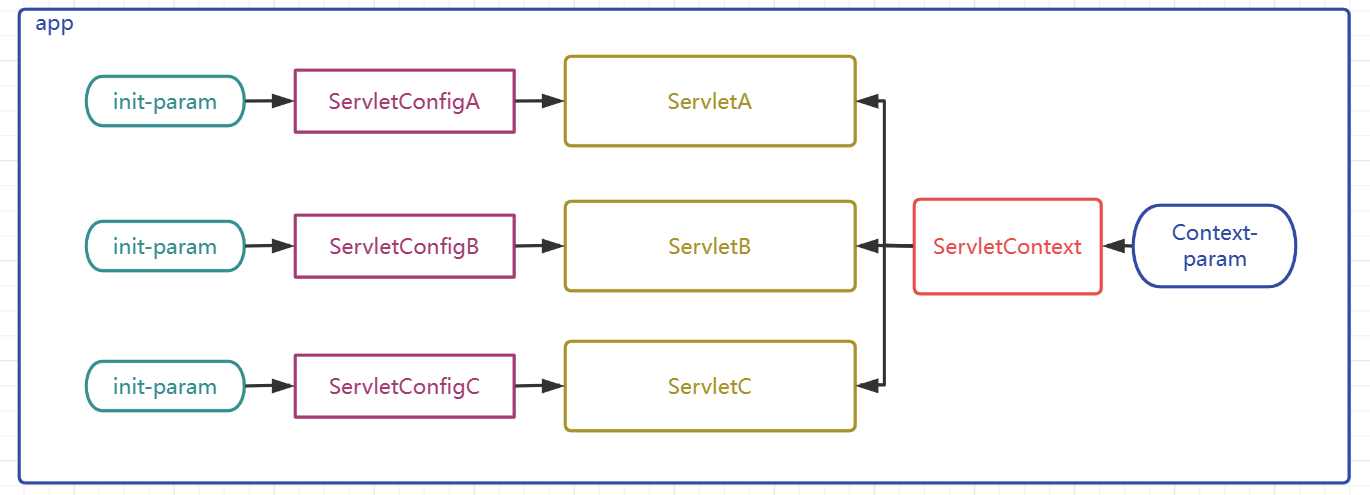
配置ServletContext参数
<?xml version="1.0" encoding="UTF-8"?>
<web-app xmlns="https://jakarta.ee/xml/ns/jakartaee"
xmlns:xsi="http://www.w3.org/2001/XMLSchema-instance"
xsi:schemaLocation="https://jakarta.ee/xml/ns/jakartaee https://jakarta.ee/xml/ns/jakartaee/web-app_5_0.xsd"
version="5.0">
<context-param>
<param-name>paramA</param-name>
<param-value>valueA</param-value>
</context-param>
<context-param>
<param-name>paramB</param-name>
<param-value>valueB</param-value>
</context-param>
</web-app>
service方法中使用
public class ServletA extends HttpServlet {
@Override
protected void service(HttpServletRequest req, HttpServletResponse resp) throws ServletException, IOException {
// 从ServletContext中获取为所有的Servlet准备的参数
ServletContext servletContext = this.getServletContext();
String valueA = servletContext.getInitParameter("paramA");
System.out.println("paramA:" + valueA);
// 获取所有参数名
Enumeration<String> initParameterNames = servletContext.getInitParameterNames();
// 迭代并获取参数名
while (initParameterNames.hasMoreElements()) {
String paramaterName = initParameterNames.nextElement();
System.out.println(paramaterName+":"+servletContext.getInitParameter(paramaterName));
}
}
}
源码,也是将数据封装到map集合中
public class ApplicationContext implements ServletContext {
private final Map<String, String> parameters = new ConcurrentHashMap<>();
@Override
public String getInitParameter(final String name) {
// Special handling for XML settings as the context setting must
// always override anything that might have been set by an application.
if (Globals.JASPER_XML_VALIDATION_TLD_INIT_PARAM.equals(name) && context.getTldValidation()) {
return "true";
}
if (Globals.JASPER_XML_BLOCK_EXTERNAL_INIT_PARAM.equals(name)) {
if (!context.getXmlBlockExternal()) {
// System admin has explicitly changed the default
return "false";
}
}
return parameters.get(name);
}
@Override
public Enumeration<String> getInitParameterNames() {
Set<String> names = new HashSet<>(parameters.keySet());
// Special handling for XML settings as these attributes will always be
// available if they have been set on the context
if (context.getTldValidation()) {
names.add(Globals.JASPER_XML_VALIDATION_TLD_INIT_PARAM);
}
if (!context.getXmlBlockExternal()) {
names.add(Globals.JASPER_XML_BLOCK_EXTERNAL_INIT_PARAM);
}
return Collections.enumeration(names);
}
}
ServletContext域对象API
| API | 功能解释 |
|---|---|
| void setAttribute(String key,Object value); | 向域中存储/修改数据 |
| Object getAttribute(String key); | 获得域中的数据 |
| void removeAttribute(String key); | 移除域中的数据 |
6、HttpServletRequest和HttpServletRequest
HttpServletRequest
- HttpServletRequest是一个
接口,其父接口是ServletRequest - HttpServletRequest是Tomcat将
请求报文转换封装而来的对象,在Tomcat调用service方法时传入 - HttpServletRequest代表客户端发来的请求,所有请求中的信息都可以通过该对象获得

常用api如下:
- 获取请求行信息相关(方式,请求的url,协议及版本)
| API | 功能解释 |
|---|---|
| StringBuffer getRequestURL(); | 获取客户端请求的url |
| String getRequestURI(); | 获取客户端请求项目中的具体资源 |
| int getServerPort(); | 获取客户端发送请求时的端口 |
| int getLocalPort(); | 获取本应用在所在容器的端口 |
| int getRemotePort(); | 获取客户端程序的端口 |
| String getScheme(); | 获取请求协议 |
| String getProtocol(); | 获取请求协议及版本号 |
| String getMethod(); | 获取请求方式 |
- 获得请求头信息相关
| API | 功能解释 |
|---|---|
| String getHeader(String headerName); | 根据头名称获取请求头 |
| Enumeration getHeaderNames(); | 获取所有的请求头名字 |
| String getContentType(); | 获取content-type请求头 |
- 获得请求参数相关
| API | 功能解释 |
|---|---|
| String getParameter(String parameterName); | 根据请求参数名获取请求单个参数值 |
| String[] getParameterValues(String parameterName); | 根据请求参数名获取请求多个参数值数组 |
| Enumeration getParameterNames(); | 获取所有请求参数名 |
| Map<String, String[]> getParameterMap(); | 获取所有请求参数的键值对集合 |
| BufferedReader getReader() throws IOException; | 获取读取请求体的字符输入流 |
| ServletInputStream getInputStream() throws IOException; | 获取读取请求体的字节输入流 |
| int getContentLength(); | 获得请求体长度的字节数 |
- 其他API
| API | 功能解释 |
|---|---|
| String getServletPath(); | 获取请求的Servlet的映射路径 |
| ServletContext getServletContext(); | 获取ServletContext对象 |
| Cookie[] getCookies(); | 获取请求中的所有cookie |
| HttpSession getSession(); | 获取Session对象 |
| void setCharacterEncoding(String encoding) ; | 设置请求体字符集 |
HttpServletResponse
- HttpServletResponse是一个
接口,其父接口是ServletResponse - HttpServletResponse是Tomcat预先创建的,在Tomcat调用service方法时传入
- HttpServletResponse代表对客户端的响应,该对象会被转换成
响应报文发送给客户端,通过该对象我们可以设置响应信息
常用api如下:
- 设置响应行相关
| API | 功能解释 |
|---|---|
| void setStatus(int code); | 设置响应状态码 |
- 设置响应头相关
| API | 功能解释 |
|---|---|
| void setHeader(String headerName, String headerValue); | 设置/修改响应头键值对 |
| void setContentType(String contentType); | 设置content-type响应头及响应字符集(设置MIME类型) |
- 设置响应体相关
| API | 功能解释 |
|---|---|
| PrintWriter getWriter() throws IOException; | 获得向响应体放入信息的字符输出流 |
| ServletOutputStream getOutputStream() throws IOException; | 获得向响应体放入信息的字节输出流 |
| void setContentLength(int length); | 设置响应体的字节长度,其实就是在设置content-length响应头 |
- 其他API
| API | 功能解释 |
|---|---|
| void sendError(int code, String message) throws IOException; | 向客户端响应错误信息的方法,需要指定响应码和响应信息 |
| void addCookie(Cookie cookie); | 向响应体中增加cookie |
| void setCharacterEncoding(String encoding); | 设置响应体字符集 |
MIME类型
- MIME类型,可以理解为文档类型,用户表示传递的数据是属于什么类型的文档
- 浏览器可以根据MIME类型决定该用什么样的方式解析接收到的响应体数据
- 可以这样理解: 前后端交互数据时,告诉对方发给对方的是 html/css/js/图片/声音/视频/… …
- tomcat/conf/web.xml中配置了常见文件的拓展名和MIMIE类型的对应关系
- 常见的MIME类型举例如下
| 文件拓展名 | MIME类型 |
|---|---|
| .html | text/html |
| .css | text/css |
| .js | application/javascript |
| .png /.jpeg/.jpg/… … | image/jpeg |
| .mp3/.mpe/.mpeg/ … … | audio/mpeg |
| .mp4 | video/mp4 |
| .m1v/.m1v/.m2v/.mpe/… … | video/mpeg |
二、过滤器
1、过滤器概述
- Filter,即过滤器,是JAVAEE技术规范之一,作用目标资源的请求进行过滤的一套技术规范,是Java Web项目中
最为实用的技术之一 Filter接口定义了过滤器的开发规范,所有的过滤器都要实现该接口- Filter的常用应用包括但不限于: 登录权限检查,解决网站乱码,过滤敏感字符,日志记录,跨域的处理…
过滤器工作位置图解
- Filter的工作位置是项目中所有目标资源之前,容器在
创建HttpServletRequest和HttpServletResponse对象后,会先调用Filter的doFilter方法 - Filter的doFilter方法可以控制请求是否继续,如果放行,则请求继续,如果拒绝,则请求到此为止,由过滤器本身做出响应
- Filter不仅可以对请求做出过滤,也可以在目标资源做出响应前,对响应再次进行处理
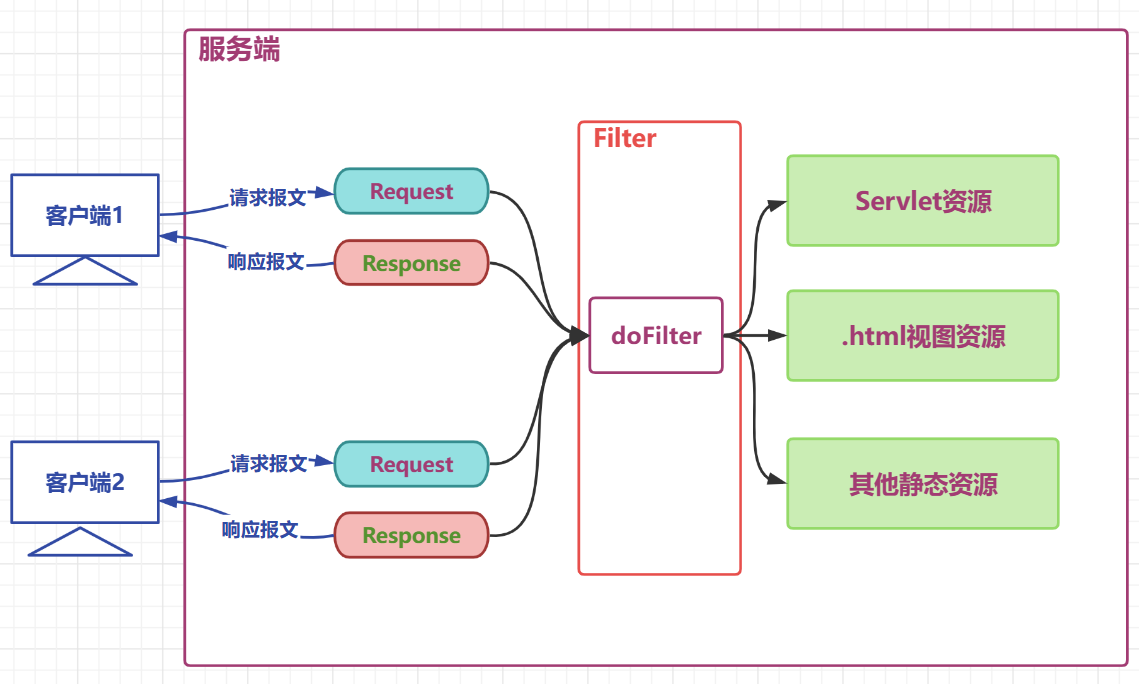
2、过滤器使用
2.1、Filter接口
- init:初始化方法,由容器调用并传入初始配置信息filterConfig对象
- doFilter:过滤方法,核心方法,过滤请求,决定是否放行,响应之前的其他处理等都在该方法中
- destroy:销毁方法,容器在回收过滤器对象之前调用的方法
package jakarta.servlet;
import java.io.IOException;
public interface Filter {
// 初始化方法
default public void init(FilterConfig filterConfig) throws ServletException {
}
// 过滤方法
public void doFilter(ServletRequest request, ServletResponse response, FilterChain chain)
throws IOException, ServletException;
// 销毁方法
default public void destroy() {
}
}
2.2、web.xml配置过滤器
过滤器实现程序执行时间
日志过滤器,实现Filter接口
public class LoggingFilter implements Filter {
@Override
public void doFilter(ServletRequest servletRequest, ServletResponse servletResponse, FilterChain filterChain) throws IOException, ServletException {
// 参数父转子
HttpServletRequest request = (HttpServletRequest) servletRequest;
HttpServletResponse response = (HttpServletResponse) servletResponse;
// 拼接日志文本
String requestURI = request.getRequestURI();
String time = new SimpleDateFormat("yyyy-MM-dd HH:mm:ss").format(new Date());
// 打印日志
System.out.println(requestURI + "在" + time + "被请求了");
// 获取系统时间
long t1 = System.currentTimeMillis();
// 放行请求
// 如果没有这一行代码,则请求到此为止
filterChain.doFilter(request, response);
// 获取系统时间
long t2 = System.currentTimeMillis();
// 打印日志
System.out.println(requestURI + "在" + time + "的请求耗时:" + (t2 - t1) + "毫秒");
}
}
Servlet程序
@WebServlet(urlPatterns = "/servletFilter",name = "servletFilterName")
public class ServletFilter extends HttpServlet {
@Override
protected void service(HttpServletRequest req, HttpServletResponse resp) throws ServletException, IOException {
// 处理器请求
System.out.println("servletFilter处理请求的方法,耗时10毫秒");
// 模拟处理请求耗时
try {
Thread.sleep(10);
} catch (InterruptedException e) {
throw new RuntimeException(e);
}
}
}
web.xml
<?xml version="1.0" encoding="UTF-8"?>
<web-app xmlns="http://xmlns.jcp.org/xml/ns/javaee"
xmlns:xsi="http://www.w3.org/2001/XMLSchema-instance"
xsi:schemaLocation="http://xmlns.jcp.org/xml/ns/javaee http://xmlns.jcp.org/xml/ns/javaee/web-app_4_0.xsd"
version="4.0">
<!--配置filter,并为filter起别名-->
<filter>
<filter-name>loggingFilter</filter-name>
<filter-class>com.xc.mvc.filter.LoggingFilter</filter-class>
</filter>
<!--为别名对应的filter配置要过滤的目标资源-->
<filter-mapping>
<filter-name>loggingFilter</filter-name>
<!--方式一:通过映射路径确定过滤资源-->
<url-pattern>/servletFilter</url-pattern>
<!--方式二:通过servlet别名确定过滤资源-->
<servlet-name>servletFilterName</servlet-name>
<!--方式三:通过后缀名确定过滤资源-->
<url-pattern>*.html</url-pattern>
</filter-mapping>
</web-app>
- filter-mapping标签中定义了过滤器对那些资源进行过滤
- 子标签
url-pattern通过映射路径确定过滤范围- /servletA 精确匹配,表示对servletA资源的请求进行过滤
- .html 表示对以.action结尾的路径进行过滤
/*表示对所有资源进行过滤一个filter-mapping下可以配置多个url-pattern
- 子标签
servlet-name通过servlet别名确定对那些servlet进行过滤- 使用该标签确定目标资源的前提是servlet已经起了别名
- 一个filter-mapping下可以定义多个servlet-name
- 一个filter-mapping下,servlet-name和url-pattern子标签可以同时存在
2.3、@WebFilter注解方式配置过滤器
@WebFilter(
filterName = "loggingFilter",
urlPatterns = {"/servletA","*.html"},
servletNames = {"servletBName"}
)
public class LoggingFilter implements Filter {
@Override
public void doFilter(ServletRequest servletRequest, ServletResponse servletResponse, FilterChain filterChain) throws IOException, ServletException {
// 过滤业务代码
}
}
三、监听器
1、监听器概述
- 监听器:专门用于对
域对象对象身上发生的事件或状态改变进行监听和相应处理的对象 - 监听器使用的感受类似JS中的事件,被观察的对象发生某些情况时,自动触发代码的执行
- 监听器并不监听web项目中的所有组件,仅仅是对
三大域对象做相关的事件监听 - 监听器的分类
application域监听器ServletContextListenerServletContextAttributeListenersession域监听器 HttpSessionListener HttpSessionAttributeListener HttpSessionBindingListener HttpSessionActivationListenerrequest域监听器 ServletRequestListener ServletRequestAttributeListener
2、application域监听器
- ServletContextListener 监听ServletContext对象的
创建与销毁 - ServletContextEvent对象代表从ServletContext对象身上捕获到的事件,通过这个事件对象我们可以获取到ServletContext对象
| 方法名 | 作用 |
|---|---|
| contextInitialized(ServletContextEvent sce) | ServletContext创建时调用 |
| contextDestroyed(ServletContextEvent sce) | ServletContext销毁时调用 |
- ServletContextAttributeListener 监听ServletContext中
属性的添加、移除和修改
| 方法名 | 作用 |
|---|---|
| attributeAdded(ServletContextAttributeEvent scab) | 向ServletContext中添加属性时调用 |
| attributeRemoved(ServletContextAttributeEvent scab) | 从ServletContext中移除属性时调用 |
| attributeReplaced(ServletContextAttributeEvent scab) | 当ServletContext中的属性被修改时调用 |
- ServletContextAttributeEvent对象代表属性变化事件,它包含的方法如下:
| 方法名 | 作用 |
|---|---|
| getName() | 获取修改或添加的属性名 |
| getValue() | 获取被修改或添加的属性值 |
| getServletContext() | 获取ServletContext对象 |
定义监听器
@WebListener
public class ApplicationListener implements ServletContextListener, ServletContextAttributeListener {
// 监听初始化
@Override
public void contextInitialized(ServletContextEvent sce) {
ServletContext application = sce.getServletContext();
System.out.println("application" + application.hashCode() + " initialized");
}
// 监听销毁
@Override
public void contextDestroyed(ServletContextEvent sce) {
ServletContext application = sce.getServletContext();
System.out.println("application" + application.hashCode() + " destroyed");
}
// 监听数据增加
@Override
public void attributeAdded(ServletContextAttributeEvent scae) {
String name = scae.getName();
Object value = scae.getValue();
ServletContext application = scae.getServletContext();
System.out.println("application" + application.hashCode() + " add:" + name + "=" + value);
}
// 监听数据移除
@Override
public void attributeRemoved(ServletContextAttributeEvent scae) {
String name = scae.getName();
Object value = scae.getValue();
ServletContext application = scae.getServletContext();
System.out.println("application" + application.hashCode() + " remove:" + name + "=" + value);
}
// 监听数据修改
@Override
public void attributeReplaced(ServletContextAttributeEvent scae) {
String name = scae.getName();
Object value = scae.getValue();
ServletContext application = scae.getServletContext();
Object newValue = application.getAttribute(name);
System.out.println("application" + application.hashCode() + " change:" + name + "=" + value + " to " + newValue);
}
}
定义触发监听器的Servlet
@WebServlet(urlPatterns = "/servletListener")
public class ServletListener extends HttpServlet {
@Override
protected void service(HttpServletRequest req, HttpServletResponse resp) throws ServletException, IOException {
ServletContext application = this.getServletContext();
// 新增application域的数据
application.setAttribute("k1", "v1");
// 修改application域中的数据
application.setAttribute("k1", "value1");
// 删除application域中的数据
application.removeAttribute("k1");
}
}
执行结果:
tomcat启动和关闭会执行ServletContextListener监听器的初始化和销毁方法Application域对象的增删改会执行ServletContextAttributeListener监听器的对应方法
application110534608 initialized
...
application110534608 add:k1=v1
application110534608 change:k1=v1 to value1
application110534608 remove:k1=value1
...
application110534608 destroyed
session域监听器和request域监听器与application域监听器唯一不同的就是监听对象不一样
3、session域的两个特殊监听器
3.1、session绑定监听器
- HttpSessionBindingListener 监听
当前监听器对象在Session域中的增加与移除
| 方法名 | 作用 |
|---|---|
| valueBound(HttpSessionBindingEvent event) | 该类的实例被放到Session域中时调用 |
| valueUnbound(HttpSessionBindingEvent event) | 该类的实例从Session中移除时调用 |
- HttpSessionBindingEvent对象代表属性变化事件,它包含的方法如下:
| 方法名 | 作用 |
|---|---|
| getName() | 获取当前事件涉及的属性名 |
| getValue() | 获取当前事件涉及的属性值 |
| getSession() | 获取触发事件的HttpSession对象 |
定义监听器
public class MySessionBindingListener implements HttpSessionBindingListener {
// 监听绑定
@Override
public void valueBound(HttpSessionBindingEvent event) {
HttpSession session = event.getSession();
String name = event.getName();
System.out.println("MySessionBindingListener"+this.hashCode()+" binding into session"+session.hashCode()+" with name "+name);
}
// 监听解除绑定
@Override
public void valueUnbound(HttpSessionBindingEvent event) {
HttpSession session = event.getSession();
String name = event.getName();
System.out.println("MySessionBindingListener"+this.hashCode()+" unbond outof session"+session.hashCode()+" with name "+name);
}
}
定义触发监听器的Servlet
@WebServlet(urlPatterns = "/servletA",name = "servletAName")
public class ServletA extends HttpServlet {
@Override
protected void service(HttpServletRequest req, HttpServletResponse resp) throws ServletException, IOException {
HttpSession session = req.getSession();
// 绑定监听器
session.setAttribute("bindingListener",new MySessionBindingListener());
// 解除绑定监听器
session.removeAttribute("bindingListener");
}
}
3.2、钝化活化监听器
- HttpSessionActivationListener 监听
某个对象在Session中的序列化与反序列化 - HttpSessionEvent对象代表事件对象,通过getSession()方法获取事件涉及的HttpSession对象
| 方法名 | 作用 |
|---|---|
| sessionWillPassivate(HttpSessionEvent se) | 该类实例和Session一起钝化到硬盘时调用 |
| sessionDidActivate(HttpSessionEvent se) | 该类实例和Session一起活化到内存时调用 |
如何配置钝化活化

文件中配置钝化
<?xml version="1.0" encoding="UTF-8"?>
<Context>
<Manager className="org.apache.catalina.session.PersistentManager" maxIdleSwap="1">
<Store className="org.apache.catalina.session.FileStore" directory="d:\mysession"></Store>
</Manager>
</Context>
定义监听器
public class ActivationListener implements HttpSessionActivationListener, Serializable {
// 监听钝化
@Override
public void sessionWillPassivate(HttpSessionEvent se) {
HttpSession session = se.getSession();
System.out.println("session with JSESSIONID "+ session.getId()+" will passivate");
}
// 监听活化
@Override
public void sessionDidActivate(HttpSessionEvent se) {
HttpSession session = se.getSession();
System.out.println("session with JSESSIONID "+ session.getId()+" did activate");
}
}
定义触发监听器的Servlet
@WebServlet(urlPatterns = "/servletA",name = "servletAName")
public class ServletA extends HttpServlet {
@Override
protected void service(HttpServletRequest req, HttpServletResponse resp) throws ServletException, IOException {
HttpSession session = req.getSession();
// 添加数据
session.setAttribute("k1","v1");
// 添加钝化活化监听器
session.setAttribute("activationListener",new ActivationListener());
}
}


